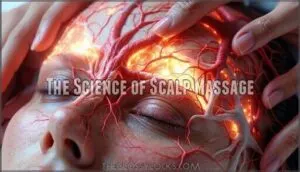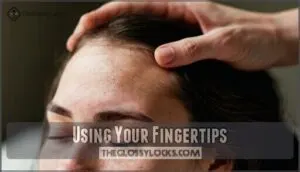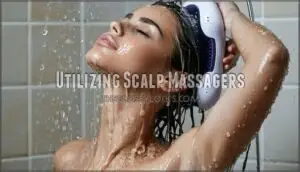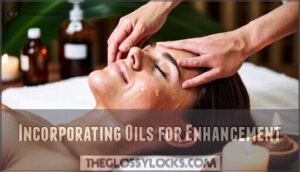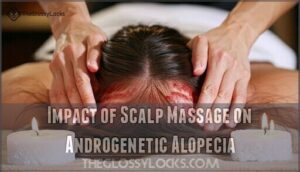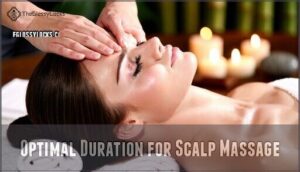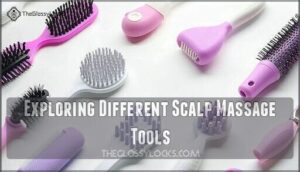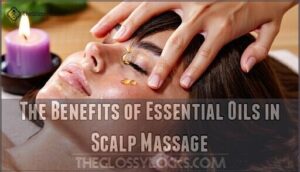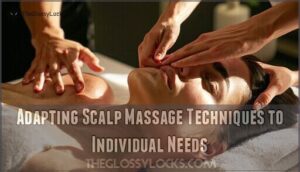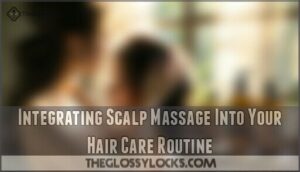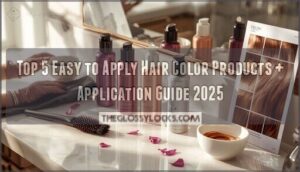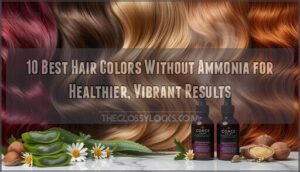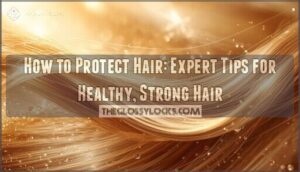This site is supported by our readers. We may earn a commission, at no cost to you, if you purchase through links.
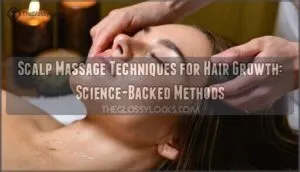
Start by using your fingertips to make small circular motions across your entire scalp, applying gentle pressure like you’re shampooing. This increases blood flow to hair follicles, delivering essential nutrients.
Try the kneading method too—use your palms to gently squeeze and release sections of your scalp. For best results, massage for 4-5 minutes each day, preferably with natural oils like rosemary or peppermint.
Think of it as a mini spa session that your follicles will thank you for. The right tools and timing can amplify these benefits substantially.
Table Of Contents
- Key Takeaways
- Understanding Hair Follicle Stimulation
- The Science of Scalp Massage
- Techniques to Promote Blood Flow
- Impact of Scalp Massage on Androgenetic Alopecia
- Stress Reduction and Its Effect on Hair Growth
- Optimal Duration for Scalp Massage
- Exploring Different Scalp Massage Tools
- The Benefits of Essential Oils in Scalp Massage
- Adapting Scalp Massage Techniques to Individual Needs
- Integrating Scalp Massage Into Your Hair Care Routine
- Frequently Asked Questions (FAQs)
- How many minutes should I massage my scalp for hair growth?
- How do you stimulate hair follicles on your scalp?
- Does massaging your head make it grow faster?
- What are the disadvantages of scalp massagers?
- Can scalp massage help with dandruff or dry scalp?
- Is scalp massage safe for people with scalp psoriasis?
- How does scalp massage affect hair texture and shine?
- Can scalp massage stimulate growth of facial hair?
- Are there any contraindications for scalp massage techniques?
- Can scalp massage cause hair breakage or damage?
- Conclusion
Key Takeaways
- You’ll boost blood flow to hair follicles by massaging your scalp with circular fingertip motions for 4-5 minutes daily, which delivers essential nutrients and activates growth factors at the cellular level.
- You can enhance your massage routine by incorporating natural oils like rosemary or peppermint mixed with carrier oils, creating a nourishing treatment that penetrates overnight for maximum follicle stimulation.
- You’ll see the best results by maintaining consistency for at least 6 months, as research shows nearly 70% of people with hair loss experienced improvements after performing daily 20-minute scalp massages.
- You can reduce stress-related hair loss through regular scalp massage, which lowers cortisol levels that disrupt normal hair growth cycles and weaken follicle health.
Understanding Hair Follicle Stimulation
When you understand how follicle activation works, you’re already ahead of the game in promoting hair growth.
Understanding follicle activation puts you miles ahead in the hair growth game.
Your hair follicles are like tiny factories that need the right conditions to produce strong, healthy strands.
Think of scalp massage as your personal delivery service – it boosts blood circulation to carry essential nutrients directly to these follicles.
This improved nutrient delivery triggers cellular mechanisms that wake up dormant follicles and encourage active ones to work harder.
The gentle pressure from scalp stimulation also releases growth factors, which are your scalp’s natural cheerleaders for hair production.
Better scalp health means your follicles can focus on what they do best: growing hair.
When you massage your scalp regularly, you’re creating an environment where follicles thrive.
It’s not magic – it’s science working in your favor, one gentle circle at a time.
The Science of Scalp Massage
While scalp massage might seem like simple relaxation, the science reveals fascinating cellular mechanisms at work beneath your fingertips.
When you apply gentle pressure, you’re triggering complex follicle biology processes that can transform your hair’s destiny.
Here’s what happens during scalp stimulation:
- Blood circulation increases, delivering oxygen and nutrients to starved hair follicles
- Growth factors activate within the dermal papilla, your follicle’s command center
- Mechanical pressure awakens dormant follicles, like gently nudging them back to life
- Your scalp microbiome responds positively, creating healthier growing conditions
Research shows that consistent scalp massage literally rewrites your hair’s genetic expression, upregulating over 2,600 genes linked to hair growth.
Transform your hair’s destiny at the cellular level – one gentle massage rewrites thousands of growth genes.
It’s not magic—it’s measurable molecular changes happening right under your scalp.
Some studies even suggest it can improve blood flow benefits to the scalp.
Techniques to Promote Blood Flow
You can boost blood flow to your scalp using three main methods: fingertip massage, scalp massagers, and oil-enhanced techniques.
Each approach stimulates circulation differently, and you’ll find that consistent pressure and circular motions work best for encouraging healthy hair growth.
Using Your Fingertips
Four simple steps transform your fingertips into powerful hair growth tools. Proper fingertip placement starts at your hairline, using circular motions with medium pressure to maximize scalp circulation. Duration consistency matters—aim for 4-10 minutes daily to see results.
Scalp massage can also improve hair health by increasing blood flow.
Essential pressure application techniques include:
- Scalp coverage from temples to crown using small circular movements
- Gentle kneading motions that stimulate hair follicle activity without causing discomfort
- Alternating between light and medium pressure to optimize blood flow
Master these massage techniques for effective scalp massage that promotes natural hair growth through improved circulation.
Utilizing Scalp Massagers
Electric and manual scalp massage tools deliver consistent pressure that your fingers can’t match.
Waterproof options work perfectly in the shower, combining hair washing with growth stimulation. Choose silicone or wooden device materials for gentleness, while metal provides deeper pressure control.
Clean your scalp massager after each use to prevent buildup. Daily massage frequency with these hair growth stimulation tools optimizes blood circulation better than traditional scalp massage methods alone.
Some studies suggest essential oils benefits can further enhance results, providing an additional way to enhance hair growth.
Incorporating Oils for Enhancement
Enhancement through oils transforms your scalp massage into a powerhouse treatment for hair growth stimulation. Proper oil selection and application techniques maximize circulation benefits while nourishing follicles directly.
- Carrier Oil Selection: Choose jojoba, coconut, or almond oils that penetrate effectively
- Oil Heating Benefits: Warm oils slightly to enhance absorption and circulation
- Spot Test Importance: Test on small skin areas before full scalp application
- Oil Mixture Ratios: Blend 8-10 drops essential oils with 2 tablespoons carrier oil
- Overnight Oil Treatment: Leave oils in overnight for maximum follicle nourishment
- Application Timing: Apply before bedtime for thorough overnight absorption
Many people find jojoba oil effective for hair.
Impact of Scalp Massage on Androgenetic Alopecia
If you’re dealing with androgenetic alopecia, also known as male or female pattern baldness, scalp massage might offer some hope for slowing hair loss and encouraging regrowth.
Research shows that nearly 70% of people with this common condition saw improvements after performing daily 20-minute scalp massages for six to eight months.
If you’re dealing with androgenetic alopecia, also known as male or female pattern baldness, scalp massage might offer some hope for slowing hair loss and encouraging regrowth.
Research shows that nearly 70% of people with this common condition saw improvements after performing daily 20-minute scalp massages for six to eight months.
Halting Hair Loss
Now that you understand how scalp massage promotes blood flow, let’s explore its power against androgenetic alopecia.
Research shows 69% of people with this condition experienced hair loss stabilization through consistent massage.
Early intervention matters here—combining scalp massage with DHT blockers and addressing nutritional deficiencies creates a thorough approach.
While medication side-effects vary, lifestyle changes like daily massage sessions averaging 11-20 minutes can substantially slow hair loss progression within seven months.
Enhancing Hair Follicle Health
Beyond stopping hair loss, scalp massage actively nourishes your hair follicles at the cellular level.
Each massage session delivers fresh oxygen and nutrients directly to follicle roots, creating an ideal growth environment.
This mechanical stimulation influences gene expression, encouraging dormant follicles to reactivate and supporting your scalp’s natural microbiome balance.
- Cellular Nutrition – Direct nutrient delivery to follicle cells through improved circulation
- Follicle Oxygenation – Enhanced blood flow increases oxygen supply for healthy growth
- DHT Reduction – Mechanical stress may help counteract hair-damaging hormone effects
Stress Reduction and Its Effect on Hair Growth
Your stress levels directly impact your hair growth more than you might realize. When chronic stress floods your system with cortisol, it disrupts normal hair loss patterns and weakens scalp health.
This Hormonal Impact creates a domino effect that can derail your hair’s natural growth cycle.
Scalp massage offers a Holistic Approach to combat this stress-hair connection. Regular massage sessions provide effective stress relief while promoting Emotional Wellbeing. The gentle pressure signals your nervous system to relax, reducing cortisol production that damages hair follicles.
| Stress Factor | Hair Impact | Massage Benefit |
|---|---|---|
| High cortisol | Disrupted growth cycles | Hormone regulation |
| Tension buildup | Reduced blood flow | Improved circulation |
| Daily stressors | Weakened follicles | Enhanced relaxation |
These Lifestyle Changes create measurable improvements in your Stress & Hair relationship, supporting healthier growth patterns long-term. Many experience acute telogen effluvium from such stress, which is a temporary condition.
Optimal Duration for Scalp Massage
Timing matters in regard to scalp massage duration and frequency. Research reveals that consistent practice yields the best results for hair growth.
Clinical studies show that even brief daily sessions can make a substantial difference in hair thickness and overall scalp health.
Here’s what science tells us about ideal scalp massage duration:
- Minimum effective time: Start with 4-minute daily sessions, as studies demonstrate this duration produces measurable improvements in hair thickness over 24 weeks.
- Enhanced benefits: Extend sessions to 11-20 minutes twice daily for maximum therapeutic effects, with nearly 70% of participants reporting improved hair retention.
- Long-term commitment: Maintain your daily routine for at least 6 months to observe noticeable changes, with optimal results appearing after 10+ months of consistent practice.
Session length directly correlates with effectiveness. Whether you’re dealing with thinning hair or simply want to promote hair growth, dedicating time to regular scalp massage pays dividends for your hair’s future health.
Exploring Different Scalp Massage Tools
While your fingertips work great for scalp massage, you’ll find that specialized tools can make the process easier and more effective.
These tools, from silicone brushes to handheld massagers, help you apply consistent pressure and reach every spot on your scalp without tiring your hands, making the massage more effective.
Brushes for Scalp Massage
Scalp brushes transform your hair growth routine with their specialized bristle design.
Choose silicone or natural bristles for gentle stimulation without scratching.
These scalp massage tools work effectively on both wet and dry hair, making them versatile additions to your routine.
Regular cleaning keeps brushes hygienic.
These brushes can offer noticeable scalp brush benefits for healthier hair growth.
The consistent pressure from scalp brushes delivers proven scalp massage benefits with their ability to provide gentle stimulation, making them a valuable tool for your hair care routine, and ultimately leading to better hair growth.
Handheld Massagers
When choosing handheld massagers for scalp massage, you’re investing in targeted hair growth stimulation.
These scalp massage devices offer superior precision compared to manual techniques, with various Massager Materials like silicone and rubber providing different sensations.
You can find a variety of options online.
- Ergonomic Design guarantees comfortable grip during extended sessions
- Pressure Levels adjust to your sensitivity and comfort preferences
- Portability Options make travel-friendly scalp massage tools convenient
- Cleaning Methods vary by material, requiring proper maintenance for hygiene
These scalp massage devices transform your routine into an effective, relaxing experience.
The Benefits of Essential Oils in Scalp Massage
Essential Oils in Scalp Massage – Introduction
You can enhance your scalp massage routine by adding essential oils like peppermint and lavender, which research shows may stimulate hair follicles and promote growth.
These concentrated plant extracts work best when mixed with carrier oils like coconut or jojoba, creating a powerful combination that nourishes your scalp while you massage.
Selecting The Right Essential Oils
When diving into essential oils for scalp massage with oils, you’ll want to focus on proven performers like lavender oil, peppermint oil, and rosemary oil.
Consider your hair type when sourcing oils – oily scalps benefit from lighter options while dry scalps need richer blends.
Always prioritize oil safety by choosing carrier oils for blending oils properly, and note that some studies suggest they may improve androgenic alopecia, which can be a key benefit of using these essential oils for scalp massage, ultimately leading to healthier hair through proper care.
Application and Best Practices
Getting started with essential oils requires finding your sweet spot for concentration and pressure.
Consider your scalp sensitivity and hair condition when choosing oils.
Mix 8-10 drops with carrier oil, then massage gently using ideal pressure for 5-10 minutes.
Adjust scalp massage frequency based on your hair growth goals, incorporating technique variation and ensuring product compatibility with your routine.
Adapting Scalp Massage Techniques to Individual Needs
Why should everyone follow the same scalp massage routine when we’re all wonderfully different? Your hair type and scalp sensitivity determine which scalp massage techniques work best for you.
Those with fine hair need gentler massage pressure, while thick hair can handle more intensity. If you have oil allergies, skip certain essential oils and focus on dry massage methods instead.
Creating your personalized routine means listening to your scalp’s feedback. Here’s how to customize your approach:
- Test different pressure levels to find your sweet spot
- Adjust frequency based on how your scalp responds
- Choose tools that match your comfort level
- Time sessions when they fit your lifestyle best.
Remember, the best scalp massage methods are the ones you’ll actually stick with consistently.
Integrating Scalp Massage Into Your Hair Care Routine
Now that you’ve mastered different scalp massage techniques, it’s time to weave this practice into your daily hair care routine.
Think of scalp massage as the secret ingredient that transforms ordinary hair care into something extraordinary.
Here’s your roadmap for seamless lifestyle integration:
- Massage Frequency: Start with 3-4 sessions weekly, building consistency before increasing frequency based on your hair type’s response.
- Product Compatibility: Time your scalp routine during shampoo application or when applying leave-in treatments for maximum absorption.
- Routine Timing: Morning massages energize, while evening sessions promote relaxation and overnight oil penetration.
- Hair Type Adaptation: Adjust pressure and duration based on your scalp’s sensitivity and hair thickness.
Frequently Asked Questions (FAQs)
How many minutes should I massage my scalp for hair growth?
You’ll want to massage your scalp for 4-5 minutes daily.
Research shows this duration effectively stimulates blood flow and hair follicles.
Some studies used 20-minute sessions, but shorter massages still deliver benefits.
How do you stimulate hair follicles on your scalp?
You’ll stimulate hair follicles by massaging your scalp with fingertips using circular motions.
Apply moderate pressure for 5-20 minutes daily.
This increases blood flow, delivering nutrients to follicles and potentially promoting healthier hair growth.
Does massaging your head make it grow faster?
Scalp massage can potentially boost hair growth by increasing blood flow to follicles.
Research shows daily four-minute massages may lead to thicker hair after six months, though you’ll need consistent practice for results.
What are the disadvantages of scalp massagers?
Like Goldilocks’ porridge, scalp massagers can be too much of a good thing.
You might experience over-stimulation, scalp irritation, or hair breakage from excessive pressure.
Some people develop dependency, neglecting gentler hand massage techniques, which can lead to a reliance on scalp massagers that is not healthy.
Can scalp massage help with dandruff or dry scalp?
Yes, regular scalp massage can help with dandruff and dry scalp.
It loosens flaky skin, improves blood circulation, and helps distribute natural oils.
You’ll also enhance the effectiveness of anti-dandruff shampoos and treatments, which can be a significant benefit for people struggling with dandruff.
Is scalp massage safe for people with scalp psoriasis?
Gentle scalp massage can be beneficial for psoriasis, but you’ll want to avoid aggressive pressure or scratching. Use light, circular motions and skip essential oils during flare-ups to prevent irritation.
How does scalp massage affect hair texture and shine?
Picture your hair strands as wilted flowers receiving fresh water.
Regular scalp massage improves blood circulation, delivering nutrients that enhance your hair’s natural shine and softness.
You’ll notice smoother texture and increased luster within weeks.
Can scalp massage stimulate growth of facial hair?
Scalp massage won’t stimulate facial hair growth. Facial hair follicles are different from scalp follicles and respond primarily to hormones like testosterone, not increased blood circulation from massage techniques.
Are there any contraindications for scalp massage techniques?
While scalp massage feels like a miracle cure, you shouldn’t massage if you’ve got open wounds, severe skin conditions, recent scalp surgery, or active infections.
Skip it during migraines too—pressure can worsen your pain.
Can scalp massage cause hair breakage or damage?
Yes, you can damage your hair if you’re too aggressive.
Using excessive pressure, pulling too hard, or massaging with dirty nails can cause breakage.
Keep it gentle and clean for best results.
Conclusion
Mastering these scalp massage techniques for stimulating hair growth transforms your daily routine into a therapeutic ritual.
You’ve learned evidence-based methods that boost blood circulation, reduce stress, and nourish follicles naturally.
Whether you prefer fingertip massage, specialized tools, or essential oil treatments, consistency remains key.
Dedicate just five minutes daily to these techniques, and you’ll likely notice improved hair texture and growth over time, which is a simple yet powerful investment in healthier hair.
Your scalp deserves this investment.
- https://www.researchgate.net/publication/295813635_Standardized_Scalp_Massage_Results_in_Increased_Hair_Thickness_by_Inducing_Stretching_Forces_to_Dermal_Papilla_Cells_in_the_Subcutaneous_Tissue
- https://editverse.com/scalp-massage-the-circulation-science-that-stimulates-hair-follicles/
- https://pmc.ncbi.nlm.nih.gov/articles/PMC5088109/
- https://perfecthairhealth.com/scalp-massages-androgenic-alopecia-study/
- https://www.goodrx.com/well-being/alternative-treatments/scalp-massage-for-hair-growth?srsltid=AfmBOor4dyBtWq9_CHMEPjwBkp2meNo08iOulkYbVOOowgsODZRehGdD

